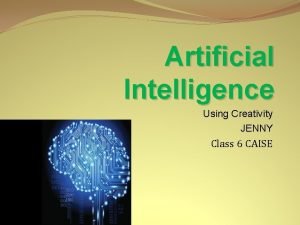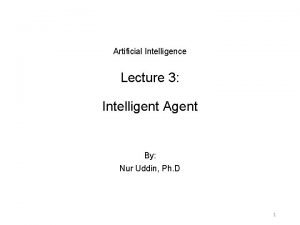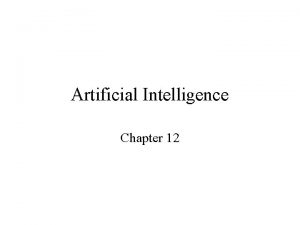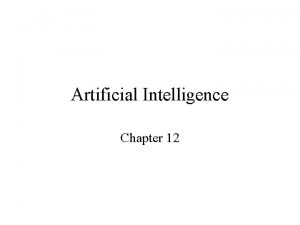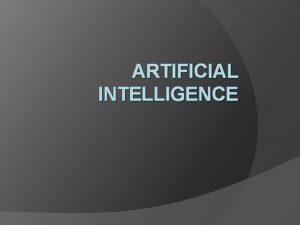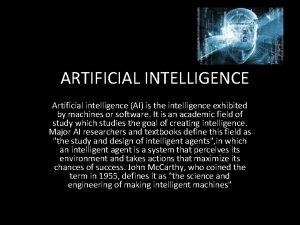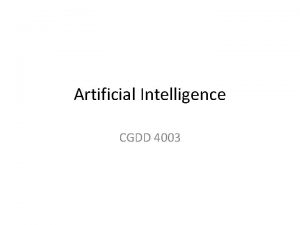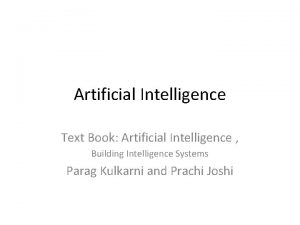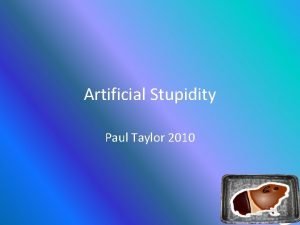Artificial Intelligence Definition What does Artificial Intelligence AI




















- Slides: 20

Artificial Intelligence Definition - What does Artificial Intelligence (AI) mean? Artificial intelligence (AI) is an area of computer science that emphasizes the creation of intelligent machines that work and react like humans. Or It is a branch of the Computer Science that aims to develop intelligent computer machines. Goals of AI To Create Expert Systems − The systems which exhibit intelligent behavior, learn, demonstrate, explain, and advice its users. To Implement Human Intelligence in Machines − Creating systems that understand, think, learn, and behave like humans.

What do we need to give machine to be intelligent • • • capacity of logic Understanding Self-awareness Learning Emotional knowledge Reasoning Planning Creativity Problem solving

• Applications of AI : • AI has been dominant in various fields such as − • Gaming − AI plays crucial role in strategic games such as chess, poker, tic-tac-toe, etc. , where machine can think of large number of possible positions based on heuristic knowledge. • Natural Language Processing − It is possible to interact with the computer that understands natural language spoken by humans. • Expert Systems − There are some applications which integrate machine, software, and special information to impart reasoning and advising. They provide explanation and advice to the users.

• Vision Systems − These systems understand, interpret, and comprehend visual input on the computer. For example, – A spying aeroplane takes photographs, which are used to figure out spatial information or map of the areas. – Doctors use clinical expert system to diagnose the patient. – Police use computer software that can recognize the face of criminal with the stored portrait made by forensic artist. • Speech Recognition − Some intelligent systems are capable of hearing and comprehending the language in terms of sentences and their meanings while a human talks to it. It can handle different accents, slang words, noise in the background, change in human’s noise due to cold, etc.

• Handwriting Recognition − The handwriting recognition software reads the text written on paper by a pen or on screen by a stylus. It can recognize the shapes of the letters and convert it into editable text. • Intelligent Robots − Robots are able to perform the tasks given by a human. They have sensors to detect physical data from the real world such as light, heat, temperature, movement, sound, bump, and pressure. They have efficient processors, multiple sensors and huge memory, to exhibit intelligence. In addition, they are capable of learning from their mistakes and they can adapt to the new environment.

Components of AI • Learning • There a number of different forms of learning as applied to artificial intelligence. The simplest is learning by trial and error. • For example, a program that learns the past tense of regular English verbs by rote will not be able to produce the past tense of a word such as jump unless it previously had been presented with jumped, whereas a program that is able to generalize can learn the “add ed” rule and so form the past tense of jump based on experience with similar verbs.

Reasoning : • To reason is to draw inferences appropriate to the situation. Inferences are classified as either deductive or inductive. • Deductive reasoning(truth): to derive as a conclusion from something known or assumed. Examples of deductive reasoning: if , 1 =2 (premise ) and 2 =3 (premise ) then , 1 =3 (conclusion ) • Since all humans are mortal, and I am a human, then I am mortal. • That dog is growling so be careful or you might get bitten. (It is logica that the dog is angry, he might bite. ) • There are three people in my family. Each one is tall, so everyone in my family is tall.

• Examples of inductive reasoning(assumed): • Jennifer always leaves for school at 7: 00 a. m. Jennifer is always on time. Jennifer assumes, then, that she if she leaves at 7: 00 a. m. for school today, she will be on time. • John is an excellent swimmer. His family has a swimming pool. John's sister Mary must also be an excellent swimmer. • All brown dogs in the park today are small dogs. Therefore, all small dogs must be brown. • Every time you eat peanuts, you start to cough. You are allergic to peanuts. • The chair in the living room is red. The chair in the dining room is red. The chair in the bedroom is red. All the chairs in the house are red.

Basis for comparison Definition Approach Starts from Validity Usage Process Argument Structure Deductive Reasoning Deductive reasoning is the form of valid reasoning, to deduce new information or conclusion from known related facts and information. Deductive reasoning follows a topdown approach. Deductive reasoning starts from Premises. In deductive reasoning conclusion must be true if the premises are true. Use of deductive reasoning is difficult, as we need facts which must be true. Inductive Reasoning Inductive reasoning arrives at a conclusion by the process of generalization using specific facts or data. Inductive reasoning follows a bottom-up approach. Inductive reasoning starts from the Conclusion. In inductive reasoning, the truth of premises does not guarantee the truth of conclusions. Use of inductive reasoning is fast and easy, as we need evidence instead of true facts. We often use it in our daily life. Theory→ hypothesis→ Observationspatterns→confirmation. →patterns→hypothesis→Theory. In deductive reasoning, arguments In inductive reasoning, arguments may be valid or invalid. may be weak or strong. Deductive reasoning reaches from Inductive reasoning reaches from general facts to specific facts to general facts.

• Problem solving, particularly in artificial intelligence, may be characterized as a systematic search through a range of possible actions in order to reach some predefined goal or solution. • in the case of a simple robot this might consist of PICKUP, PUTDOWN, MOVEFORWARD, MOVEBACK, MOVELEFT, and MOVERIGHT—until the goal is reached.

• Perception: • Perception is a process to interpret, acquire, select and then organize the sensory information that is captured from the real world. • For example: Human beings have sensory receptors such as touch, taste, smell, sight and hearing. So, the information received from these receptors is transmitted to human brain to organize the received information. • · According to the received information, action is taken by interacting with the environment to manipulate and navigate the objects. • .

• Language • A language is a system of signs having meaning by convention. In this sense, language need not be confined to the spoken word. Traffic signs, for example, form a minilanguage, it being a matter of convention that �means “hazard ahead” in some countries

• Types of Artificial Intelligence:

• 1. Reactive Machines • Purely reactive machines are the most basic types of Artificial Intelligence. • Such AI systems do not store memories or past experiences for future actions. • These machines only focus on current scenarios and react on it as per possible best action. • IBM's Deep Blue system is an example of reactive machines. • Google's Alpha. Go is also an example of reactive machines.

• 2. Limited Memory: • Limited memory machines can store past experiences or some data for a short period of time. • These machines can use stored data for a limited time period only. • Self-driving cars are one of the best examples of Limited Memory systems. These cars can store recent speed of nearby cars, the distance of other cars, speed limit, and other information to navigate the road.

• 3. Theory of Mind • Theory of Mind AI should understand the human emotions, people, beliefs, and be able to interact socially like humans. • This type of AI machines are still not developed, but researchers are making lots of efforts and improvement for developing such AI machines.

• 4. Self-Awareness • Self-awareness AI is the future of Artificial Intelligence. These machines will be super intelligent, and will have their own consciousness, sentiments, and selfawareness. • These machines will be smarter than human mind. • Self-Awareness AI does not exist in reality still and it is a hypothetical concept.

• Machine learning: • “Algorithms that parse data, learn from that data, and then apply what they’ve learned to make informed decisions”. • Example 1 – Machine Learning – Predicting weights based on height • Example 2 – Storm prediction System

Deep learning: • It is a subfield of machine learning. • It uses a programmable neural network that enables machines to make accurate decisions without help from humans. • A great example of deep learning is Google’s Alpha. Go. • Example 1 – Shape detection • Example 2 – Cat vs. Dog

• Deep learning is a machine learning technique that teaches computers to do what comes naturally to humans: learn by example. Deep learning is a key technology behind driverless cars, enabling them to recognize a stop sign, or to distinguish a pedestrian from a lamppost. It is the key to voice control in consumer devices like phones, tablets, TVs, and handsfree speakers. Deep learning is getting lots of attention lately and for good reason. It’s achieving results that were not possible before.
 Expert system architecture in artificial intelligence
Expert system architecture in artificial intelligence Iterative deepening search prolog
Iterative deepening search prolog Searching for solutions in artificial intelligence
Searching for solutions in artificial intelligence 15-780 graduate artificial intelligence
15-780 graduate artificial intelligence Knowledge manipulation in ai
Knowledge manipulation in ai Types of knowledge in ai
Types of knowledge in ai Colbert, stephen. home page. 1 nov. 2006.
Colbert, stephen. home page. 1 nov. 2006. Artificial intelligence leadership
Artificial intelligence leadership Uas kecerdasan buatan
Uas kecerdasan buatan Math and artificial intelligence
Math and artificial intelligence Medical diagnosis system peas
Medical diagnosis system peas 15-780 graduate artificial intelligence
15-780 graduate artificial intelligence Xkcd artificial intelligence
Xkcd artificial intelligence Fuzzy propositions
Fuzzy propositions Cse 571 asu
Cse 571 asu 15-780 graduate artificial intelligence
15-780 graduate artificial intelligence Informed search and uninformed search in ai
Informed search and uninformed search in ai Artificial intelligence for class 6
Artificial intelligence for class 6 Levels of language analysis
Levels of language analysis Omniscience in artificial intelligence
Omniscience in artificial intelligence What is the alan turing test
What is the alan turing test

















